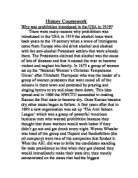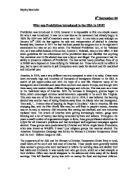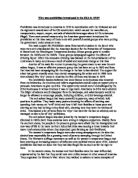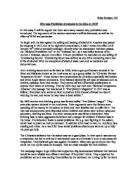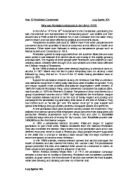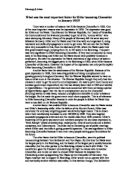Why was prohibition bound to fail?
GCSE HISTORY COURSEWORK ASSIGNMENT A (objective 1) Why was prohibition bound to fail? 3. Was prohibition bound to fail? For what seemed to be the end of lots of the social problems in the USA, turned out to make the country a more violent place. At the start, prohibition gained great support, but in the end the whole country turned against the idea. Prohibition was first introduced in 1919 as the 18th amendment of the American constitution. It lasted for 14 years before in 1933 the 21st amendment, or the Volstead act was passed. There are many reasons as to why prohibition didn't work. The USA was riddled with corruption and violence, all brought along by the introduction of prohibition. In the USA, before prohibition, Alcohol provided a social activity for most American citizens. This was one of the biggest problems with the law, people just wanted to have a legal drink. Nearly all American citizens had an urge for an alcoholic beverage. This signalled that prohibition was going to have problems with gaining it's needed support. If there is no support for a law, it will cause a lot of trouble trying to uphold the law. Another factor, which boded greatly against prohibition, was the natural human ethic, to want to break laws. When a law is made, there are always some people who will want to go against it and break it. Because of these two factors, ordinary people wouldn't
Why was prohibition introduced?
Why was prohibition introduced? Eugenics is the study of races. It developed in the USA in the 1900's. Eugenicists believed that if the American people stopped drinking then they would become better (healthier) people. This led to Prohibition and in this essay I will explain the events that led to Prohibition. Eugenicists believed that alcoholism was a major problem in America. People would take days off wok due to illnesses caused by drinking too much. It was also a cause of domestic violence as fathers would come back from the saloons drunk and so arguments would brake out in the household. It also led people to poverty which led people to theft but the biggest problem of all was probably a new trend of loose sexual morals. Many people believed that if alcoholism was banned, then all these problems would stop, in the end they were proved to be wrong. Women believed that a lot of the political discussions were taking place in the saloons and they were not allowed to have a say in them. Women believed that if the saloons were shut down then political discussions would come out into the mainstream and they would then have a say in political discussions. The movement to ban the sale of alcohol began in the American mid-west and was taken up by Protestant churches (Anti-Saloon League) and women's groups (Women's Temperance Movement). The leading prohibition
Why was prohibition introduced in the USA in 1919?
History Coursework Why was prohibition introduced in the USA in 1919? There were many reasons why prohibition was introduced in the USA in 1919 the alcohol issue went back years to the 19 century when a wave of immigrants came from Europe who did drink alcohol and clashed with the anti-alcohol Protestant settlers that were already there. The Protestants claimed that alcohol was the cause of lots of diseases and that it caused the man to become violent and neglect his family. In 1875 a group of women set up the 'National Women's Christian Temperance Union' after Elizabeth Thompson who was the leader of a group of women protesters that went round all of the saloons in there town and protested by praying and singing hymns to try and close them down. This idea spread and in 1880 the NWCTU succeeded in making Kansas the first state to become dry. Once Kansas became dry other states began to follow. A few years after that in 1893 a new organisation was set up 'The Anti Saloon League' which was a group of powerful American business men who wanted prohibition because they thought that there workers would work better if they didn't go out and get drunk every night. Wynne Wheeler was head of the group and Dupont and Rockefellers (the oil company) were two of the companies that funded it. What the ASL did was to bribe the candidates standing for state presidency so that when they got
Why was Prohibition introduced in the USA in 1919?
8th September 04 Why was Prohibition introduced in the USA in 1919? Prohibition was introduced in 1919; however it is impossible to find one simple reason for why it was introduced. It was not a new idea as the movement had already begun in 1830. By 1914 over half of America's states were 'dry'. At one minute past midnight on January 16th 1920 the law against the sale and transportation of alcohol in America became law; however in 1917 the law had been passed by congress due to the eighteenth amendment but was not put into action. The National Prohibition Act, or the Volstead Act, as it was called because of its author, Andrew J. Volstead, was put into effect. It laid down guidelines for the enforcement of the prohibition laws and clarified that anything that contained over 0.5% alcohol was now a liquor and illegal. The government had the ability to prosecute violators of Prohibition. The law carried heavy penalties; fines of up to $1000 were imposed on those defying the Volstead Act. Those who could not afford to pay, had to spent six months in jail. Exceptions were made for alcohol used for medicinal and industrial uses. America, in 1919, was a very different country compared to what it is today. Crime rates were extremely high and hundreds of thousands of immigrants flocked to the USA in search of job opportunities and with the hope of a new life. However many of the
Why was prohibition introduced in the USA in 1919?
Why was prohibition introduced in the USA in 1919? Prohibition was introduced to America in 1919 in coordination with the Volstead act and the eighteenth amendment of the US constitution: which caused the manufacture, transportation, import, export, and sale of alcoholic beverages above 0.5 % to become illegal. There were several reasons why the American government introduced the prohibition at this time many of them to do with powerful social groups who were putting the government under pressure to act. The main support for Prohibition came from moral crusaders in the South who were very anti-urbanisation like the American Society for the Promotion of Temperance in Boston and the Washington Temperance Society, whose groups grew in number between the 1820's and the 1840's. These groups campaigned against the effects of drinking liquor. Often this excessive drinking was blamed on the industrialisation of the rural areas in many counties as a result of social and economic change at this time Another of the main for-runner in pressuring the government to act was the anti-saloon league. It was an effective pressure group that had been set up in 1893 and from that time had been campaigning for the change in the law to ban alcohol. The support for a ban had grown steadily since they started campaigning for action and in 1908 there were already five 'dry' states in America the
Why was Prohibition introduced in the USA in 1919?
Ruby Rumjon 11E Why was Prohibition introduced in the USA in 1919? In this essay it will be argued that there were many reasons why prohibition was introduced. The arguments of the various movements will be discussed, as well as the effect of WWI and patriotism. To begin with the law against the selling and making of alcohol in America was passed by congress in 1917, due to the eighteenth amendment; it didn't come into effect until January 16th 1920 at precisely midnight. Shortly after the amendment had been passed, the 'National Prohibition Act' or the 'Volstead Act', as it was called because of its Author J Volstead, was put into effect. This act prohibited the manufacture and selling of 'intoxicating liquors'. Intoxicating liquor was defined as any drink containing more than 0.5% of alcohol. With the exceptions of alcohol made uses such as medicine and industrial uses. Anti- drinking issues went as far back as 1830, when a group of women situated in the West and Midlands known as the rural areas set up a group called the "Christian Women Temperance Union". These women were predominantly Christians especially Methodists and white Anglo-Saxon protestants. They blamed alcohol for all types of diseases such as cholera, epilepsy, fever and murder. They started off with illustrated publications to express their views on drinking. Then by 1876 they had their own 'National
Why was Prohibition introduced in the USA in 1919?
Year 10 Prohibition Coursework Lucy Sparks 10A Why was Prohibition introduced in the USA in 1919? In the USA in 1919 the 18th Amendment to the Constitution, prohibiting the sale, manufacture and transportation of "intoxicating liquor", was ratified and then became law in1920 under the Volstead Act. It was a decision that had taken many years to reach and had been effected by political and economic issues. Temperance societies date back to 1808 in New York when people became concerned about the quantities of alcohol consumed and its effects on health and behaviour. Other states soon followed in setting up temperance groups such as Massachusetts and Connecticut in 1813. Prohibition gained its early supporters from the southern Bible belt and rural areas where it was believed that alcohol abuse was mainly in the rapidly growing industrial cities. The majority of these people were Protestants who believed in hard working values. Drinkers were thought of as bad workers and their habits offended the Christian morals of Protestants. By the 1850s individual states were already beginning to introduce bans on alcohol. In 1851 Maine was the first to place temporary bans on alcohol, a lead followed by many that led to 13 out of the 31 states having prohibition laws in place by 1855. Support for prohibition declined during the
Why was the Munich Agreement signed on 29 September 1938?
Why was the Munich Agreement signed on 29 September 1938? The Munich Agreement was an agreement between Britain, France, Germany and Italy by which a part of Czechoslovakia called the Sudetenland was ceded to Germany. To understand why the agreement was signed it is necessary to look at what had been happening in Europe during the previous twenty years. After the First World War Germany had been severely punished. It had been forced to give away land and money and was not allowed to have a proper standing army. Czechoslovakia was an artificial country constructed partly from the old Austro-Hungarian Empire and as a consequence about one quarter of its population was German. During the 1930s Adolph Hitler came to power as Chancellor of Germany. He used his position to become dictator and brought about many changes in Germany. He successfully seized land such as the Rhineland and the Saar And was not stopped by any other country. He gradually built up the size of his army, navy and airforce for example, the anglo-german treaty that allowed them to increase the german navy to 35% of Britain's, and again was not stopped. He used the Luftwaffe (the german air force) in the Spanish Civil War to bomb places like Guernica. He made a pact with the other Fascist State, italy and the two tried to distablise the solidarity against germany by keeping on reasonably good terms with
Why was There a Revolution in Russia in 1905?
Why was There a Revolution in Russia in 1905? In Russia in 1905 there was a revolution. It occurred because of many long term, and short term causes, however was triggered by one main event that will be examined later. The main causes that will be looked at in detail are; the long-term political problems involving the tsar, the backward economy, and the rigid social system. The short-term causes to be examined include; the Russo-Japanese war, and the main cause, the 'Bloody Sunday' massacre. The long-term events leading up to the revolution in 1905, were mostly political problems, and the dislike of the autocratic rule at the time. The tsar tried to ease to continuing problems by emancipating the serfs, however they were still being taxed with redemption repayments. This lead to growing unrest as they called for further rights, and so it can be classed as long term cause of the revolution. This lead to the political organization the "Land and Freedom" formed by the 'Populists' or 'Narodniks'. "The People's Will", a terrorist group also formed to kill the Tsar in March 1881. When Alexander III came to power in 1881, he set about suppressing the peasants and all opposition to himself. His Russification policy forced Russian culture on the 50 million non-Russians in the empire. Censorship was also increased and the freedom of universities was reduced. Alexander's mistakes lay
Why was there a revolution in Russia in 1905?
Why was there a revolution in Russia in 1905? The Russian revolution in 1905 happened for a number of reasons. The four main reasons were the workers problems, the Russo-Japanese war, Bloody Sunday and the Tsars personality. On the morning of, January 22nd 1905, a peaceful procession made up of factory workers and there families, led by Father Gapon, went to the Winter Palace. The march to the palace was to raise awareness about how angry the workers were. The kinds of things they were angry about were long hours of work a day. An unfair wage system, and ending of the war and a duma so they can have a say about things they wanted. Instead of seeing their Tsar, two hundred of the peaceful demonstrators of the procession got shot and killed by nervous, panic stricken soldiers. Whilst this was happening, the Tsar wasn't even in the palace. This was called "Bloody Sunday" and it was all blamed on the Tsar, even though he didn't give the order to shoot those people. This made him look very sinister to all of Russia. Bloody Sunday wouldn't have happened if there weren't any problems with the workers. Russia was an 18th century country living in a 20th century world insinuating that they were behind in technology and people's rights. There were a lot of problems in Russia, for example, the population of Russia was rapidly increasing, therefore food supply was running short.




